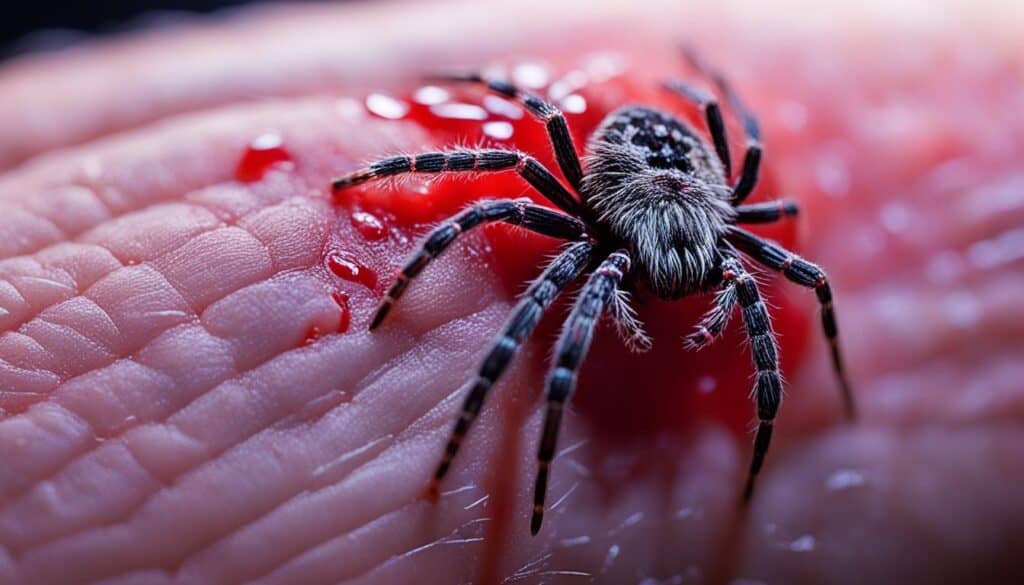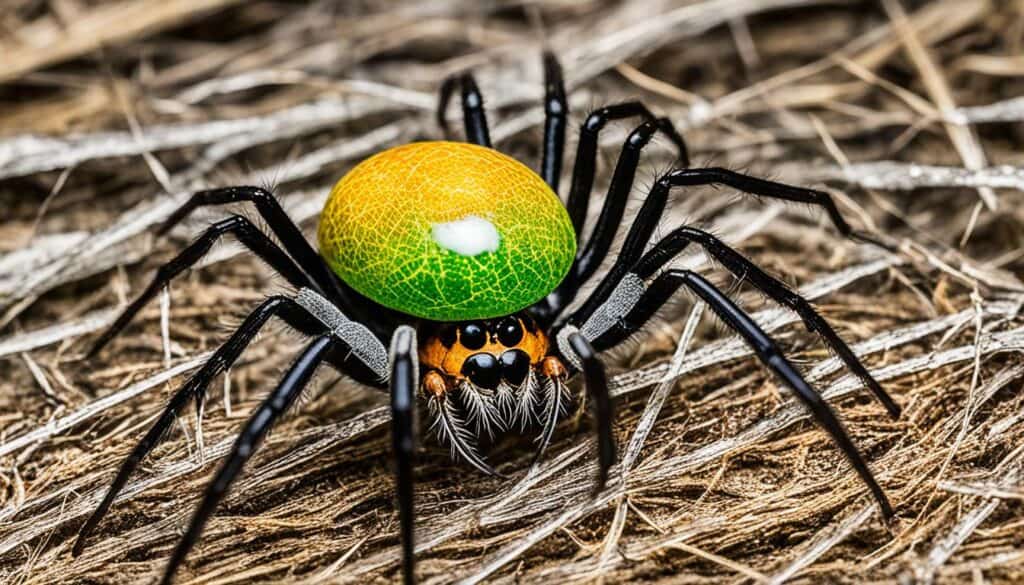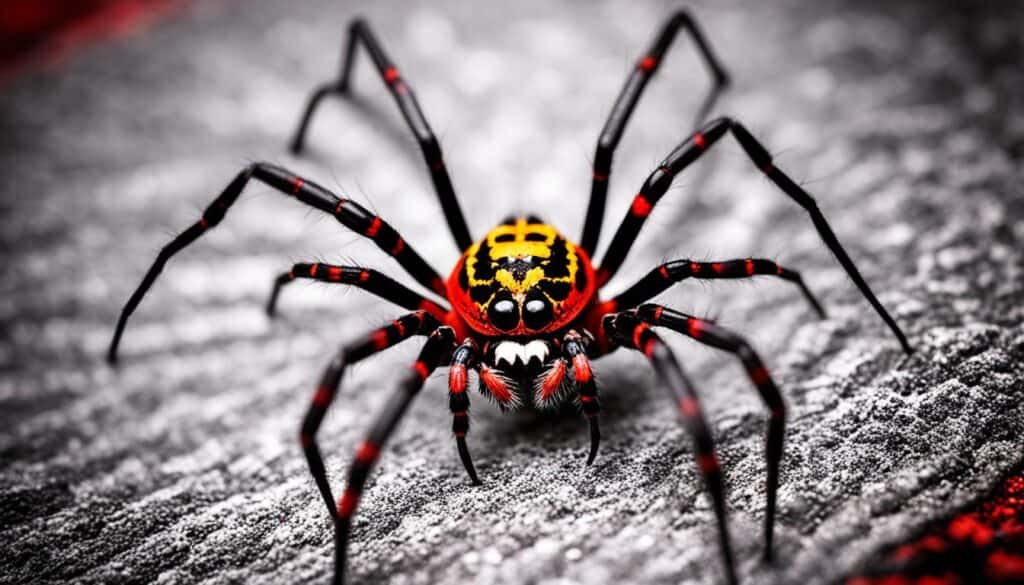Did you know Joro spiders can grow as big as a human palm? This fact might surprise you. These spiders, known scientifically as Trichonephila clavata, first appeared in the United States in 2013. They quickly became known in northeast Georgia, coming from East Asia. These spiders are not shy. They make huge six-foot-wide webs that can cover your backyard!
In New Jersey, where I live, Joro spiders keep spreading along the East Coast. It’s both intriguing and a bit scary. You can find their webs in many places, even on highways and in sheds. To learn about these spiders, researchers at the University of Georgia did over 350 tests. They used a tuning fork to mimic prey on the webs. They found out that Joro spiders near roads attack less often than those in quiet places.
It turns out these spiders are doing well because they’re careful. Even with their big size and venom, their fangs can’t hurt us. They prefer to eat insects instead of bothering humans. But knowing they’re weaving their large webs close to our homes is still unsettling. They could change our local ecosystems and how we enjoy the outdoors.
Key Takeaways
- Joro spiders, or Trichonephila clavata, were first spotted in the U.S. around 2013.
- These spiders can grow up to 4 inches in size, about the size of a human palm.
- Their golden webs can be as wide as 6 feet, often found in urban environments.
- Joro spiders are timid and tend to “freeze” when disturbed.
- Though venomous, their fangs cannot break human skin, posing minimal risk to humans.
- Researchers are studying their environmental impact and potential displacement of native species.
- Residents have noted an increase in Joro spider sightings along the East Coast.
Introduction to the Joro Spider
The colorful Joro spider, or Trichonephila clavata, is from East Asia. It has found its way into the Southern and Eastern United States. Ever curious about this invasive spider? Here’s what you need to know.
Identifying a Joro spider starts with its large size and bright colors. The adult females can be an inch long, with legs reaching three inches. These spiders stand out with their mix of yellow, blue, and red colors. They make gold-tinted webs that can be over six feet wide.
Male Joro spiders are smaller, just over a quarter of an inch. But both males and females help their kind spread.
Joro spiders start their lives in spring, from eggs laid in winter. From August to September, they’re easy to spot. They make huge webs that can be 10 feet wide!
Joros are usually harmless to people. They might bite, causing itchiness or a mild allergic reaction. But they’re more afraid of us than we are of them.
They came to the U.S. on ships and goods. Spotted first in Georgia in 2014, they’ve moved North. Young Joros “balloon” on the wind to travel. It shows, even spiders seek adventures.
Seeing one of these spiders can be startling. But they’re just trying to adapt, like we all do.
Joro Spider Interaction with Humans
My first time seeing a Joro spider was both cool and a bit scary. They have really long legs, up to three inches, so you can’t miss them. Yet, even though they look big, the Joro spider bite is not as bad as some people say. It’s like nature’s little nudge to keep your distance—usually, it’s no worse than a bee sting, unless you’re allergic. So, don’t worry too much if spiders creep you out!
Joro spiders’ venom effects aren’t harmful to us. You’re more likely to get stung by a bee than hurt by a Joro spider. Still, it’s common for people to panic when they see them. Being scared of spiders is totally real. And it often comes from wrong information.
It’s important to set the record straight during this Joro spider invasion. When Joro spiders get stressed, they tend to freeze, not attack us. Remember, they eat bugs, not people. This makes them allies in controlling pests.
Living with spiders has always been part of human life. The colorful Joro spider, originally from East Asia, is making its way into our cities. From Atlanta to Baltimore, they’ve traveled far, thanks to their unique “ballooning” trick. So, how do we deal with them moving into our spaces?
First off, knowing how they behave helps a lot. They’re not out to get us. They just want to survive, like we do. By keeping our places clean, sealing up any gaps, and clearing out webs, we can manage. And if they still make you nervous, it’s okay to call in the experts. But let’s clear up one thing: Joro spiders may look scary, but they’re not bad guys in our shared living spaces.
The Spread of Joro Spiders on the East Coast
Everywhere I look, there are new Joro spider sightings on the East Coast. They first popped up in Georgia back in 2014, described as “giant, colorful spiders.” That year marked their first appearance in the U.S.
They started in Atlanta, Georgia and spread to the Carolinas and southeastern Tennessee. Then, a satellite population formed in Baltimore over the last two years.
The way these spiders travel is both amazing and a bit scary. They use a method called “ballooning” to move around. This doesn’t involve real balloons, but young Joro spiders release silk that catches the wind. This lets them glide through the air for miles.
These spiders have rapidly spread and now can be found from Alabama to Ohio. They’re brightly colored and can grow up to three inches long. Their leg span can reach up to four inches, especially in females.
One reason they’re spreading so fast is their ability to withstand cold. A University of Georgia study found Joro spiders have a 77% higher heart rate than similar species. This higher heart rate helps them survive colder weather.
Experts think they might reach the Northeast in the next few years. Whenever it happens, we’re likely to see more of them. Their journey across the East Coast continues.
Though they’re causing a stir, Joro spiders aren’t harmful to people. Their bites are mild at worst. But they could pose a threat to local spider populations due to competition for food.
Joro Spider Behavior and Habits
The Joro spider lifecycle shows their unique web-building skill. They create large, complex webs, over 3 feet wide. These webs, with three layers, are usually outside, connecting trees or bushes.
I find Joro spiders’ homes quite stylish. They eat many insects, like grasshoppers and moths. They even eat harmful pests, like the brown marmorated stink bugs. It seems they help with pest control.
Joro spiders have a high birth rate. From September to November, females lay 1 to 5 egg sacs. Each sac has about 400 to 500 eggs. Females mature in 3 to 5 months, outpacing males. By summer’s end, a new generation is ready.
Human activity influences Joro spiders’ seasonal habits. They are more common near buildings when their habitats are disturbed. They prefer outdoors, making homes in places like firewood stacks. When threatened, they tend to freeze, showing their shy side.
Their bites might sting a bit and cause redness, but it’s not worse than a bee sting. Their venom isn’t dangerous to humans or pets. No allergic reactions from their bites have been serious.
Joro spiders are spreading across the East Coast. They adapt well and can be found in several states. These include Alabama, Florida, Kentucky, West Virginia, and Ohio. This showcases their strong survival and spreading capabilities.
Ecosystem Impact of Joro Spiders
Joro spiders have been in the United States since 2013, growing up to four inches long. Their size can be quite shocking. They’ve quickly made a mark here.
But they aren’t just scary. Joro spiders adapt well to cities, building webs in busy areas. In a study with 350 tests across 20 roads, researchers found they catch prey often, even near noise. They thrive in urban areas, unlike other spiders.
These spiders are helpful too. They eat pests like stink bugs and lantern flies that harm crops. Farmers benefit from having Joro spiders around because they act as natural pest control.
However, there’s a downside. Their exploding numbers can upset local ecosystems. They might overpower other bugs that are important to our environment. With global warming, they could spread even more, especially in warmer areas.
Joro spiders are venomous, but they can’t harm humans. Their bite isn’t strong enough to pierce our skin. But their increasing population could threaten local wildlife. The rise in invasive species, due to warmer weather and more trade, makes it worse.
Public Health and Safety Concerns
Let’s address the topic of Joro spiders. Unlike venomous spiders such as the Brown Recluse or the Black Widow, Joro spiders are less dangerous. Their bite might scare you more than hurt you unless you’re allergic.
Seeing their large webs and colorful bodies near your home can be unsettling. Joro females can grow up to three inches wide. Will Hudson in Winterville, Georgia, decided to act. He removed over 300 Joro spiders from his property. Still, these spiders don’t really threaten your home or pets according to safety experts.
Are these spiders planning to spread further? They first appeared near Atlanta and now they’re in South Carolina. Their quick spread puzzles experts but by late November, they usually disappear.
Some scientists like Nancy Hinkle see a positive side to Joros. They help control mosquitoes and flies. Their effect on the environment is still being studied. But don’t worry. Joro spiders won’t invade your home or bother your pets.
Prevention and Control Measures
Ah, Joro spiders. You’ve seen them, and now you’re wondering how to avoid making them roommates. I’ve got some Joro spider prevention tips for you. This guide helps you keep a spider-free zone with just a little effort and some tools.
Maintaining your home and yard is key. Joro spiders love shrubs and trees, especially near water. Keep your yard tidy. Think of it as a VIP area for you and friends. Clear clutter, mow the lawn, and trim those bushes and trees!
If the maintenance sounds hard, consider calling professionals. Many pest control services focus on spiders. They’re like Spider Busters. They’ll use a mix of strategies, including pesticides, to fight spiders.
Now, about pesticides. Yes, they seem intense. But they are needed for the larger female Joro spiders and the numerous males. Always use pesticides safely and follow directions.
The goal is to make your space unattractive to Joros and their young. By removing their attractions, you’re closer to a spider-free home. With these steps, you’ll impress every arachnophobe around!
Conclusion
So, what have we discovered about Joro spiders? These colorful creatures come from East Asia. Since 2014, they’ve spread across the East Coast, starting in Georgia. By October 2022, they’ve expanded to cover an amazing 120,000 km². States like Georgia, South Carolina, North Carolina, and Tennessee have seen them. They are even noticed in places like Alabama, Maryland, Oklahoma, and West Virginia. They sure know how to show up!
Joro spiders spread mostly by ballooning. It’s a cool way of travel where young spiders glide on silk threads in the wind. It’s fascinating and a bit surprising. Thinking about it, it’s like these spiders have their way of moving around. Meeting these spiders has made me notice the wonders around us more.
Research into Joro spiders has become pretty active. It aims at understanding their behavior and how they fit into our world. For example, studies in northeast Georgia looked at how they react to traffic and noises. Such work helps us know how to live with Joro spiders. Their webs catch pests for us, showing they’re natural pest controllers.
The Joro spider’s story tells us a lot about adapting to the environment. We need ongoing research and education to live together well. By getting to know these spiders, our fear may turn into respect. Maybe, we’ll start seeing them as helpful, unique neighbors.




